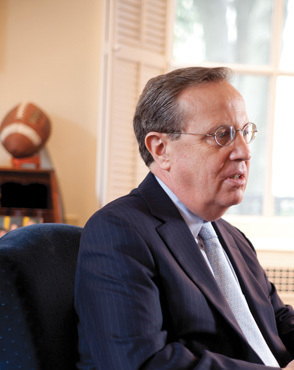 loading
loading
Q&A: Rick LevinThe evolution of Yale sports Mark OstowView full image
Y: Yale is the place where the rules of American football were created, and for decades it was a national power in football. And now Yale is a place that will never be a national power in the most popular U.S. sports. How did that happen? L: What changed after World War II was the transformation of football—and for that matter basketball—into, effectively, professional sports in the big state universities and at a number of private institutions. The growing popularity of televised sports meant there was money in it, and it became economically sensible for schools to compete for the best athletes. They did it by offering full scholarships to athletes, in many instances admitting students who didn't really belong academically. The Ivy League decided in 1954, with this trend towards athletic scholarships and professionalization, to come together formally as a league. We agreed that no Ivy League school would give athletic scholarships, that funding would be strictly need-based for all students in all of our schools, for athletes and non-athletes alike. And, despite occasional pushing against the margin, we have maintained that standard with great integrity now for more than five decades. We should be proud of that. Y: So Stanford can be nationally competitive because it gives athletic scholarships. L: Stanford may admit some students we wouldn't. But, still, Stanford occupies a niche created by the absence of the Ivy League schools. If every Ivy League school gave athletic scholarships, Stanford would be much weaker in football—because they'd be competing with eight other schools for the scarce pool of ultra-high-quality students who can play football at the championship level. Y: Yale does make it to an NCAA tournament sometimes—recently in men's hockey, volleyball, and women's soccer. And in some sports Yale has been regularly competing and winning at the top—squash, sailing, women's crew. L: True. But in football and basketball, we want to be competitive within the Ivy League. We recruit academically capable young men who can play football well but can also do well at Yale and in life. In all of our athletic programs, as in many other extracurricular activities, our students develop strengths of character that contribute to their becoming productive citizens and leaders. They learn the values of teamwork, hard work, and discipline. They learn something about strategic thinking. They develop a capacity to concentrate and a desire to excel. Y: On the question of recruiting. There are college admissions slots reserved, under Ivy rules, for varsity sports, even though admission to Yale College is incredibly competitive. L: It would be impossible to be competitive in the Ivy League if we didn't employ this system. Y: What fraction of each class are recruited athletes? L: About 13 percent. It was 17 or 18 percent when I became president. I have wanted to maintain a strong athletic program, and I believe we have demonstrated this can be accomplished without admitting quite so many athletes. We now admit significantly fewer recruited athletes than the Ivy League allows. Some of the coaches are not happy with this, understandably. But I believe we have struck the right balance between making our athletic programs successful and wanting to make the Yale experience available for students who excel in other areas. Y: I've heard alumni say, we have a president who doesn't make athletics a priority. And I've also heard from alumni on the other side. L: Alumni are divided on this subject. Some are aware that Yale has reduced the number of admissions slots for athletes, and they're not happy about it. And I also hear from alumni who ask why we reserve slots at all. Y: A couple of coaches recently left after a series of mediocre seasons. How much must the coaches weigh winning, in their jobs? L: I can't think of a single case of a coach who has been replaced exclusively because of the team's competitive performance. Winning can be a factor, but there are many other issues in assessing a coach's performance. Y: How does the total spending on varsity sports compare with that for all Yale College extracurricular arts activities? L: Extracurricular spending on the arts is less. But if you add in spending on our curricular offerings in art, architecture, music, and theater, we clearly spend more on arts than athletics. When we did our first-phase renovations of the Payne Whitney Gym and Sterling Library more than a decade ago, it was very important to me [laughs] that the budget for the library be just a little more than the budget for the gym! And today, the library budget remains more than double that of the athletics department. Y: And the final question: the last Harvard game. Fourth and 22, up by three points, three minutes to go on your own 25–yard line. What would you have done? L: [Laughs.] My job is not to coach the football team. Tom Williams is going to have a spectacular career here.
The comment period has expired.
|
|